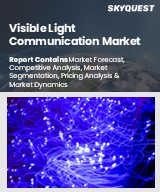
Report ID: SQMIG45H2090
Skyquest Technology's expert advisors have carried out comprehensive research on the visible light communication market to identify the major global and regional market trends and growth opportunities for leading players and new entrants in this market. The analysis is based on in-depth primary and secondary research to understand the major market drivers and restraints shaping the future development and growth of the industry.
Requirement for a Rapid and Secure Data Transfer
5G Integration and Overload of Radio Frequency Spectrum
Limited Range of Transmission
Lack of Infrastructure and Non-Standardization
REQUEST FOR SAMPLE
Global Visible Light Communication Market size was valued at USD 2.44 Billion in 2023 and is poised to grow from USD 3.45 Billion in 2024 to USD 53.85 Billion by 2032, growing at a CAGR of 41% in the forecast period (2025-2032).
There is lots of activity within the global visible light communication sector, and the players within it are heavily focusing on collaborations, research and development investments, and varying product offerings. For example, Signify has entered into agreements with business centers and schools in order to launch license-free wireless internet. rawLiFi is collaborating with original equipment manufacturers (OEMs) to implement consumer devices. There is also growth in the number of industry players venturing into the defense and healthcare industries, both of which need secure communication with low latency. There is also transformation in the environment due to market consolidation and acquisition, which results in enhanced technological capabilities and global presence. 'Signify (Philips Lighting)', 'pureLiFi', 'Oledcomm', 'VLNComm', 'Lucibel', 'Acuity Brands', 'General Electric', 'Panasonic', 'Renesas Electronics', 'Axrtek', 'Firefly LiFi', 'Fraunhofer HHI', 'Velmenni', 'Qualcomm', 'fSONA Networks'
Growing usage of VLC is being necessitated by the need for faster, more secure, and interference-free data connection. Compared to RF-based systems, VLC provides better bandwidth, electromagnetic interference immunity, and higher data rate, one that is up to 100 times higher than that of Wi-Fi connectivity. The defense sector, the medical sector, and the manufacturing sector are all relying on VLC because they are the kind of businesses that provide secure communications without sacrificing signal jamming or interception.
Adoption of Li-Fi in Consumer Electronics: One of the notable global visible light communication industry trends is the adoption of Li-Fi. Li-Fi, or "Light Fidelity," is a VLC-based replacement for Wi-Fi that is already being trialed in wearables, laptops, and smartphones to gain high internet speeds. When it comes to Li-Fi modules for OEM adoption, pureLiFi and Signify are leaders in the market. There is a chance that this trend will totally revolutionize consumer connections, especially in areas where radio frequency (RF) transmission is restricted or unreliable.
How Is North America Leading the Charge in VLC Technology Adoption?
Want to customize this report? This report can be personalized according to your needs. Our analysts and industry experts will work directly with you to understand your requirements and provide you with customized data in a short amount of time. We offer $1000 worth of FREE customization at the time of purchase.
Feedback From Our Clients

Report ID: SQMIG45H2090
sales@skyquestt.com
USA +1 351-333-4748